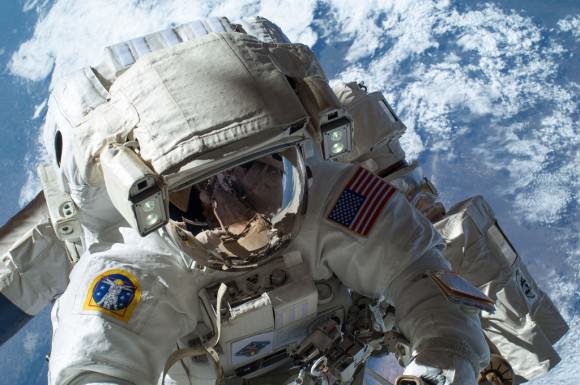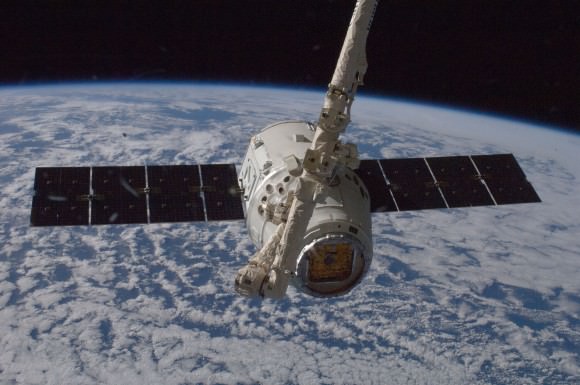It’s a good thing that next week’s urgent spacewalk is pegged as a short one, because the coming days will be hectic for the Expedition 39 crew.
Finding a spot for even a 2.5-hour excursion on the International Space Station was extremely challenging, NASA officials said in a news conference today (April 18), because crew time also is needed for two cargo spacecraft: the SpaceX Dragon launch scheduled for today and subsequent Progress undocking/redocking on station.
Here’s a rundown of some things NASA was juggling as it moves hastily to replace a failed backup computer on the outside of the station. Rick Mastracchio and Steve Swanson are expected to go “outside” on Wednesday (April 23), but if today’s SpaceX launch is delayed the spacewalk will be moved up to Sunday (April 20).
Why it’s urgent
The U.S. portion of the station has 46 computers, with 24 of them external. The multiplexer/demultiplexer or MDM (one of two) controls 12 of these external computers and is responsible for everything for how the solar arrays are pointed to how some robotics operate. It should be noted here that the primary MDM is working just fine, but if it fails with no backup, there will be problems. NASA will lose telemetry or data from the external ammonia cooling systems operating on station (although the systems themselves will work automatically). Some redundant equipment can’t be turned on, either. The agency also won’t be able to point the solar arrays to get power or to move them aside when spacecraft come in, to protect the arrays from thruster plumes (although further below you can see some backups they have for the array problems.)

Fixing the spacesuits
Since last summer’s life-threatening water leak, NASA has been moving quickly to fix the spacesuits it has. All non-urgent spacewalks are off the table until at least this summer while NASA addresses a panel’s recommendations to fix the problem. A faulty fan pump separator was swapped out on the bad suit (Suit 3011) last December, but two spacesuits still needed to be fixed on station. The crew spent much of the past week changing out a fan pump separator on Suit 3005 (which will also be used in the spacewalk) and flushing out the cooling lines in the suit and on station, since contamination is believed to have led to the failure. (More parts will arrive on Dragon, but they won’t be used this time, NASA has determined.)
Spacewalk preps on the ground
Also today, NASA astronaut Chris Cassidy was in “the pool” (at NASA’s Neutral Buoyancy Laboratory) simulating the spacewalk. He’s part of a team working to see what could go wrong on the spacewalk and come up with procedures dealing with that. “As best we can we have all those answers in our hip pockets so as they get thrown out on the game day, we can give the crew a quick answer,” he said in an interview Wednesday (April 16) on NASA TV.
Preparing the new computer
A spare MDM is inside the station, but it was an older model that needed to be reconfigured. Astronauts changed out a processing card and did other hardware/software changes to prepare the MDM to sit outside of the station. They also thoroughly tested it to make sure it’s working before mounting it outside. As a point of interest, no one yet knows why the backup MDM failed, but astronauts will inspect the site for damage (and take pictures). It’s expected that once they bring the broken MDM inside, any failed cards will be swapped out and sent to the ground sometime for analysis. The MDM itself will stay on station to be used again, as needs arise.

Grappling Dragon
SpaceX’s Dragon is a cargo spacecraft controlled by the ground, but the astronauts need to be ready to nab it with the robotic Canadarm2 once it arrives (now scheduled for Sunday, April 20). The crew has their normal amount of training and preparation for the procedures, then the time it takes to capture the spacecraft, and then the time to unload the vehicle (which is somewhat urgent as there are certain research experiments that need to come off fairly quickly, NASA said.)
Moving the solar array
NASA not only needs to have the solar arrays out of the way from thruster plumes from Dragon and Progress, but it also needs to keep power to the station and configure the arrays so that if the other MDM fails, the arrays will automatically be placed in a safe spot. The array would autotrack for 24 hours after the MDM fails, then go to a “preset angle” that NASA carefully chose. As for whether there would be power shortages on station, NASA says it depends on the sun’s angle and what needs to be done on station at a particular time.
Moving the Progress spacecraft
Russian cargo ship Progress 53 is supposed to undock from the Zvezda service module on Wednesday (April 23) to test an automated rendezvous system that controls approaches to station. Then it’s docking again on Friday (April 25).
Unless otherwise noted, information in this article is based on comments from the following officials in today’s NASA news conference: Mike Suffredini, International Space Station program manager; Brian Smith, International Space Station flight director and Glenda Brown, lead spacewalk officer.


Dreams of zero gee and views of eternity..